Rocket Mass Heater: A Sustainable Heating Solution
- October 30, 2023
- 10 comment
When it comes to sustainable heating, the Rocket Mass Heater is a game-changer, offering both innovation and efficiency. Rooted in the foundational design of the rocket stove, which emerged in the late 1980s to reduce fuel consumption and smoke emissions in developing nations, this heater takes those principles further. By combining the fuel-saving qualities of the rocket stove with the thermal efficiency of a masonry heater, the Rocket Mass Heater delivers an accessible, highly efficient solution for eco-friendly heating.
Origins of the Rocket Mass Heater

The Rocket Mass Heater traces its origins to the innovative rocket stove, first introduced in 1982 by Aprovecho as an efficient cooking solution. The term “mass” refers to the heavy masonry structure central to its design, which excels at storing and radiating heat. While masonry heaters are far from new dating back to prehistoric times they have evolved over centuries, reflecting the cultural influences of European, Russian, and Chinese architecture.
The cornerstone of these heaters remains consistent: the incorporation of an expansive thermal mass, primarily made of masonry. This structure is adept at capturing and storing heat emanating from the combustion of fuel. The meticulous design channels the exhaust from the combustion process through a winding, serpentine path within the masonry, optimizing heat absorption.
Innovation in the 1980s: The Birth of the Rocket Mass Heater
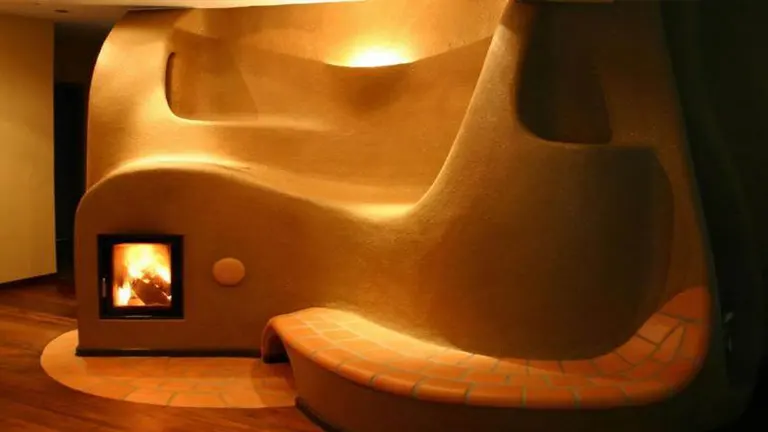
By the 1980s, the Rocket Mass Heater prototype revolutionized the heating world with unique features that set it apart from traditional masonry heaters:
- Instant Radiant Heat: Unlike masonry heaters, the Rocket Mass Heater delivers immediate warmth, thanks to its innovative design, which includes a metal “burn” barrel that radiates heat instantly.
- Affordable Construction: Building a Rocket Mass Heater is significantly more economical. Its materials—like cob (a mix of clay, sand, straw, and water), a 55-gallon steel drum, and a compact brick firebox—are cost-effective yet highly efficient.
- Flexible Foundation Needs: Unlike masonry heaters that require a reinforced base, the Rocket Mass Heater’s design distributes its weight evenly. This reduces the need for a heavy foundation, allowing it to be installed in more versatile locations.
Understanding Efficiency and Design

The Rocket Mass Heater stands out for its innovative design and exceptional efficiency. Let’s break down its structure:
- Gravity-Fed Wood Chamber: The system starts with a vertical chamber that feeds wood into an “L” or “J”-shaped horizontal burn chamber, where the initial combustion takes place.
- Secondary Burn Chamber: Hot gases are directed to an insulated secondary chamber, often encased in a metal barrel. This chamber radiates direct heat and promotes clean combustion in an oxygen-rich, high-heat environment, leaving minimal smoke after the first burn.
- Thermal Storage System: Finally, the hot gases pass through a large thermal mass, which absorbs and stores heat, gradually releasing it over several days. This not only boosts efficiency but also integrates beautifully into a building’s architecture.
Now, the efficiency aspect:
- Reduced Fuel Use: The Rocket Mass Heater consumes up to 80% less wood compared to traditional systems, making it incredibly economical.
- Clean Combustion: The J- or L-shaped burn chamber creates turbulence, driving secondary combustion. This results in a hotter, cleaner burn with fewer emissions.
Exploring the Diversity of Rocket Mass Heaters
Rocket Mass Heaters (RMHs) have become a go-to choice for those seeking eco-friendly and efficient heating solutions. Their innovative designs incorporate internally insulated chimneys, or “heat risers,” to achieve extremely high-temperature burns. This process generates the draft needed to move exhaust gases through the system.
In addition to their efficient burn, some RMH designs take it a step further by condensing steam within the exhaust gases into liquid. This clever feature releases latent heat of condensation, similar to the operation of a condensing gas boiler, boosting overall efficiency. Combined with the thermal mass, which stores and gradually releases heat, these heaters provide consistent, sustainable warmth while minimizing fuel consumption and emissions.
J-tube Style Rocket Mass Heater
The J-tube style Rocket Mass Heater is one of the earliest and most popular designs in the RMH family. Its distinctive “J-shaped” combustion tube allows wood to be gravity-fed into the system, ensuring a continuous and efficient burn. The hot gases then move into a vertical secondary combustion chamber made of well-insulated firebrick or ceramic refractory material. From there, the exhaust gases are channeled through horizontal metal ducting embedded in a substantial thermal mass. This mass retains heat for long periods and often doubles as a functional or structural element in the building. Thanks to its simplicity and efficiency, the J-tube style is widely embraced in natural construction and permaculture designs, with many units being self-built.
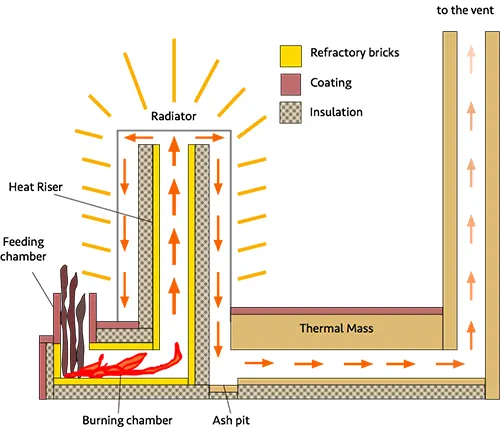
Batch-box Style Rocket Mass Heater
The batch-box style Rocket Mass Heater offers a modern alternative to the classic J-tube design. It features a batch-fed horizontal firebox that directs hot gases into a vertical heat riser or secondary combustion chamber. One of its key advantages is the ability to hold a larger volume of wood, allowing for longer, more autonomous operation without frequent refueling. A unique variation of this design replaces the horizontal duct flow with a larger “bell” structure. This innovation slows the hot gases, allowing them to stratify, while cooler gases exit near the bottom. To ensure optimal performance, the airflow must remain unobstructed, particularly at the vertical port at the rear of the firebox.
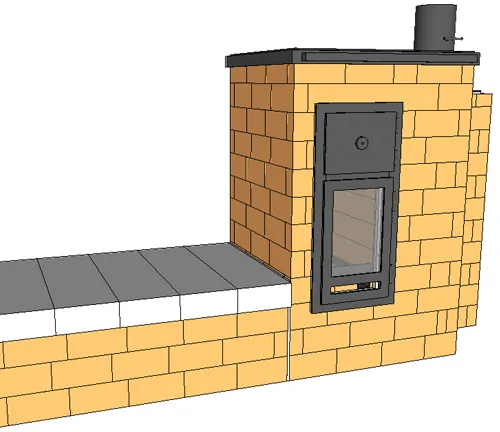
Cob Style Rocket Mass Heater
The Cob-style Rocket Mass Heater stands out for its use of cob in constructing the heat riser. Cob, a mixture of clay, sand, and straw, is known for its low thermal conductivity, making it highly effective at absorbing and retaining heat. Once the fire is extinguished, the stored heat in the cob can provide warmth for several days, reducing the need for constant fuel input.
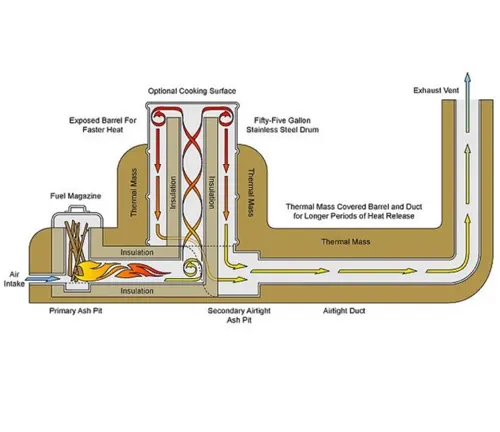
Pebble Style Rocket Mass Heater
Introduced by Paul Wheaton in 2010, the Pebble-style Rocket Mass Heater is distinct for its use of pebbles and rocks as the thermal mass. This design is significantly lighter than traditional models, making it portable and ideal for installations on wooden floors. Its reduced weight allows for easy relocation and modification, adding versatility to its practical advantages.
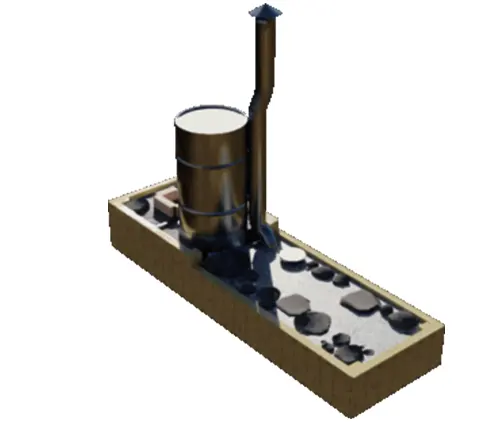
Essential Components of Rocket Mass Heaters
Rocket mass heaters have evolved into efficient heating devices, utilizing various components tailored to specific needs. Despite their variances, at their core, all rocket mass heaters consist of three fundamental components: the wood feed, the heat riser, and the heat exchange mass. Each component plays a vital role in the heater’s operation, and while the architecture within these might differ based on design, additional components may also be integrated, catering to specific requirements.
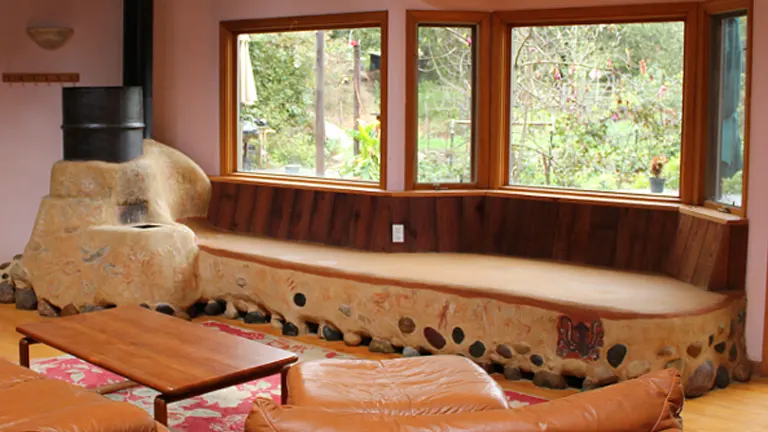
- Wood Feed: This is the gateway through which both wood and air are introduced into the system. The J-tube design features a slender wood feed that accepts wood vertically. Intricately designed, the wood feed ensures that only the lowermost parts of the wood sticks ignite. The airflow directs the fire sideways, heading toward the combustion chamber and subsequently the heat riser. This lateral fire progression curtails smoke from escaping into the environment. As the wood sticks continue to burn, they naturally progress deeper into the feed. Notably, the batch-box style heater’s wood feed can accommodate a larger volume of wood simultaneously.
- Heat Riser: Acting as the heart of the rocket mass heater, the heat riser is an insulated vertical conduit responsible for drawing flames upwards, thereby energizing the entire firebox. Insulation is paramount for the heat riser to retain high temperatures, ensuring thorough combustion. The insulating material’s low thermal conductivity aids in maintaining elevated temperatures inside the heat riser. Upon reaching the barrel that encompasses the heat riser, the hot gases release substantial heat, resulting in their cooling. This dynamic establishes a powerful convective current inside the heat riser, driving the forward airflow and consequently facilitating the sideways burning of wood in the wood feed.
- Barrel: The barrel, often with a volume of about 0.2 m^3, encapsulates the heat riser. Serving as a radiant heat source, its surface can also double up as a cooking top. To optimize the convective currents, the barrel’s construction typically employs steel or materials known for their high thermal conductivity.
- Heat Exchange Mass: This component is pivotal for transmitting the generated heat to the surroundings. Constituted by materials like cob, rocks, sand, or pebbles, this thermal mass absorbs the heat emanating from the combustion gases. Often artistically molded into a bench, the heat exchange mass doesn’t just serve a functional purpose but can also become an aesthetic centerpiece in homes.
What is Thermal Mass?
The secret to a Rocket Mass Heater’s incredible efficiency lies in its thermal mass. Think of it as a heat storage tank made from dense materials that absorb, store, and release heat slowly over time.
Picture a rock heated by a campfire long after the fire dies, the rock stays warm because it’s retained the heat and releases it gradually. A Rocket Mass Heater works the same way. Instead of letting all the heat escape quickly, the thermal mass stores it and provides steady, long-lasting warmth, keeping your space comfortable for hours, even after the fire is out.
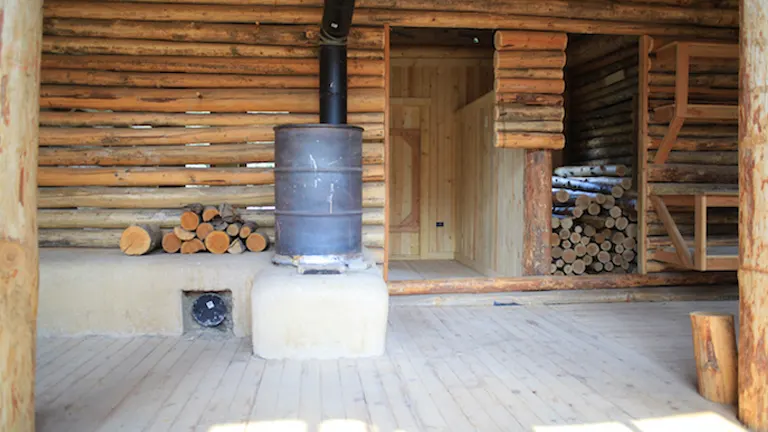
Many designs incorporate functional features, like benches or beds made from cob, adding both utility and style. But the possibilities don’t stop there Rocket Mass Heaters can warm fish ponds, greenhouses, or even help keep plants cozy during cold weather. Best of all, they use significantly less wood than traditional stoves, making them a smart, eco-friendly heating choice.
Environmental Impact
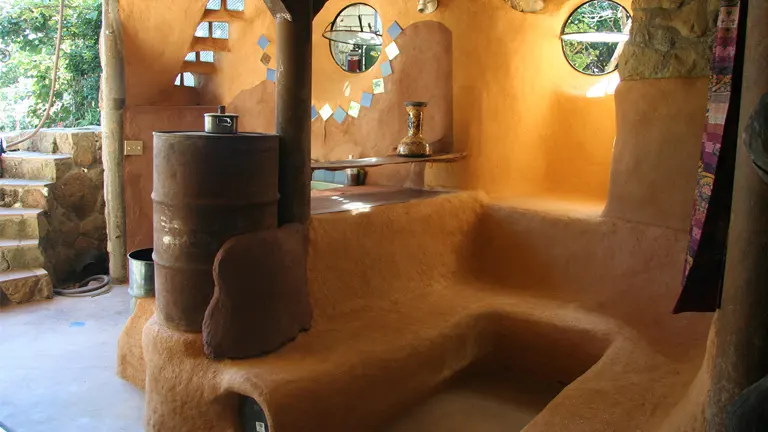
Thanks to their clean combustion technology, Rocket Mass Heaters significantly reduce greenhouse gas emissions. Traditional wood-burning systems are known to emit high levels of methane and nitrous oxide two potent contributors to global warming. In contrast, the efficient combustion process in a Rocket Mass Heater minimizes these emissions, making it a much more eco-friendly alternative. By using less wood and burning it more completely, these heaters help lower the environmental footprint of home heating.
Benefits and Disadvantages of Rocket Mass Heater
Benefits
- One of the significant benefits of rocket mass heaters is their efficiency. Some enthusiasts note that these heaters use only about 10% of the wood a conventional wood stove would consume.
- Due to the heat exchange mass’s ability to absorb and distribute the combustion heat to its surroundings, rocket mass heaters often exhibit higher thermal efficiency than other heating systems.
- A functioning rocket mass heater typically has an exhaust temperature ranging from 60–90 °C (140–194 °F). In contrast, conventional wood stoves can produce exhaust temperatures of around 400–600 °C (752–1112 °F).
- Advocates suggest that the exhaust gas from a rocket mass heater primarily comprises carbon dioxide and steam. This indicates that these heaters are adept at burning fuel more efficiently than other heaters.
- The heat exchange mass’s low thermal transmittance ensures that heat is released gradually. Some users even state that their rocket mass heaters can keep their homes warm for days, long after the wood has burnt out and the fire has extinguished.
Disadvantages
- Building a rocket mass heater is no small feat. The construction can be extensive, potentially dominating a significant portion of a room, particularly in smaller homes. This might make it less suitable for those with limited space or those not willing to dedicate such a large area to the heater.
Rocket Mass Heater vs. Conventional Wood Stove
At first glance, a conventional wood stove appears simple: a metal box with a chimney. The fire burns inside, and heat is immediately released. However, with average fire temperatures around 1,000°F, these stoves often emit unburned particles and creosote, which can accumulate in the chimney and increase the risk of dangerous chimney fires.
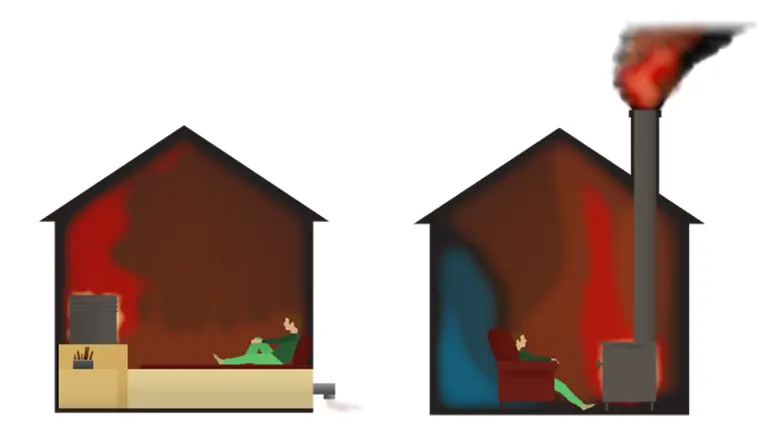
The efficiency of traditional wood stoves is also widely misunderstood. While a “75% efficiency” rating may sound impressive, this figure is often achieved under ideal laboratory conditions. In real-life use, even experienced operators typically achieve only around 35% efficiency. For those using wet or green wood or restricting airflow for a slow burn, efficiency can plummet to as low as 5%. This disparity explains why Rocket Mass Heaters are often said to heat a home with just a fraction of the wood it’s a comparison to the actual, not perceived, performance of conventional stoves.
Rocket Mass Heaters take a completely different approach. By insulating the firebox instead of the chimney, they reach combustion temperatures of over 1,800°F. This high temperature ensures nearly complete combustion, drastically reducing creosote and smoke emissions. Additionally, the exhaust leaves the system at a temperature just above room temperature, keeping more warmth inside the home rather than losing it through hot smoke. This efficient design makes Rocket Mass Heaters a safer, cleaner, and more sustainable heating solution.
To understand this in numerical terms, let’s break it down:
- The quoted “75% efficiency” often does not account for the heat that escapes up the chimney to expel smoke. Lab tests might use a figure like 14% or 16% for the smoke loss. So, a stove rated at 75% efficiency is, in reality, performing at closer to 59%.
- Furthermore, Rocket Mass Heaters lack mechanisms to reduce airflow for a slow, inefficient burn. This design ensures even an inexperienced user can achieve around 90% efficient burns consistently.
Lastly, concerns regarding creosote, a major problem with conventional wood stoves, are addressed ingeniously in Rocket Mass Heaters. In standard stoves, inefficient burning can lead to creosote accumulation in chimneys, posing a fire risk. In Rocket Mass Heaters, the “chimney” is essentially the heat riser, designed to have a controlled chimney fire with every use, preventing dangerous build-ups.
Can I Build a Rocket Mass Heater Myself?
Absolutely! One of the best things about Rocket Mass Heaters is their simplicity. Despite the name, you don’t need to be a rocket scientist to build one. With basic tools, some planning, and a willingness to learn, you can create an efficient, eco-friendly heating system for your home.
That said, safety should always come first. Since you’re working with fire indoors, it’s crucial to do thorough research and follow best practices. Fortunately, there’s no shortage of resources, from step-by-step guides to expert advice, to help you build a safe and effective system.
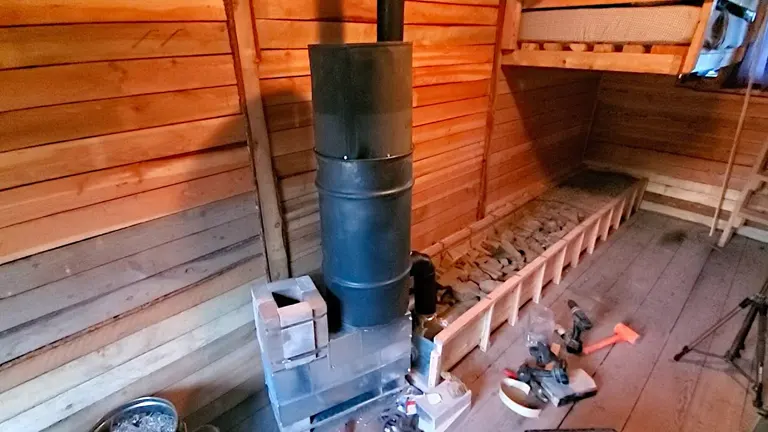
If you’re serious about this project, take the time to fully understand how a Rocket Mass Heater works. Once you’ve mastered the basics, building one could even open up new opportunities—turning your DIY skills into a marketable expertise.
Interestingly, while Rocket Mass Heaters are highly efficient, they haven’t yet become mainstream. This leaves room for enthusiasts to innovate and collaborate with industry leaders like Ernie and Erica Wisner or Paul Wheaton to push the boundaries of sustainable heating design.
Rocket Mass Heater Plans
Unlock Sustainable Heating with ‘Rocket Mass Heaters Plans’
Ready to heat your home the eco-friendly way? The ‘Better Wood Heat: DIY Rocket Mass Heaters 8-DVD Set‘ has you covered. This 8-DVD treasure from Permies offers expert guidance and step-by-step instructions for a warm, sustainable home.
Get Rocket Mass Heaters Plans now.
Link: Rocket Mass Heaters Plan
Conclusion
The evolution of Rocket Mass Heaters showcases a perfect blend of traditional knowledge and modern innovation. Over the years, their design has been refined to drastically reduce wood consumption while incorporating features like thermo siphons for better heat distribution. With their diverse designs, these heaters now offer homeowners a sustainable way to stay warm using just a fraction of the wood and smoke produced by traditional systems.
In essence, Rocket Mass Heaters deliver maximum efficiency, minimal environmental impact, and reliable warmth, making them an ideal choice for anyone pursuing sustainable living. Whether you’re an eco-conscious homeowner or a DIY enthusiast, these heaters are a practical, eco-friendly heating solution worth exploring.
FAQs
- What is the best material for a rocket mass heater?
The ideal materials for a rocket mass heater depend on its specific design and intended application. Commonly used materials include fire bricks for the combustion chamber due to their durability and heat resistance, steel drums for the heat riser to facilitate direct radiant heat, and cob, rocks, or pebbles for the thermal mass, which store and slowly release the heat. The choice of material should ensure longevity, safety, and efficient heat storage and transfer. - Do rocket mass heaters work?
Yes, rocket mass heaters are known for their efficiency and ability to produce a significant amount of heat with a small amount of fuel. They operate based on the principle of high-draft air intake, ensuring complete combustion, which results in more heat and less smoke. Their design aims to maximize the extraction of heat from the combustion gases, making them very efficient. - Can a rocket mass heater heat a house?
Absolutely. Many homeowners have successfully used rocket mass heaters as their primary heating source. One of the benefits of rocket mass heaters is the large thermal mass that stores heat and releases it gradually. This can keep a house warm for extended periods, even after the fire has gone out, depending on the size of the home and the design of the heater. - How many square feet can a rocket mass heater heat?
The heating capability of a rocket mass heater depends on its design, size, and the insulation and layout of the space it’s heating. A well-designed and properly sized rocket mass heater can efficiently heat spaces ranging from small rooms to larger homes of 1,000 square feet or more. Specific heating capabilities should be evaluated based on individual heater designs and home configurations. - Can a rocket mass heater heat water?
Yes, with the right design modifications, a rocket mass heater can also heat water. Some designs incorporate copper coils or other heat exchangers around the heat riser or within the thermal mass. As the heater operates, water circulates through these coils, getting heated in the process. This can provide hot water for domestic use or even support radiant floor heating systems.
We truly appreciate you taking the time to delve into the world of Rocket Mass Heaters with us. If you’ve found this information beneficial or have your own experiences and insights to share, we’d love to hear from you in the comments below. Engaging with a community of like-minded individuals can further the discourse and drive forward sustainable innovations. Thank you for reading, and we encourage you to share this article with others who might find it valuable!

David Murray
Forestry AuthorI'm David Murry, a forestry equipment specialist with a focus on chainsaw operation. With over 13 years of experience, I've honed my skills in operating and maintaining a wide range of machinery, from chainsaws to log splitters. My passion for the outdoors and commitment to sustainable forestry drive my work, which emphasizes safety, efficiency, and staying updated with industry advancements. Additionally, I'm dedicated to sharing my expertise and promoting environmental awareness within the forestry community.
10 comments
Hallo, sehr gut wo bekomme ich Händler nachweise und Bauanleitung. Viele Grüße Georg
Georg Goldbrunner
November 5, 2023 4:45 pmIch hoffe nur das es mit den deutschen Behörden , Schornsteinfeger, usw. Keine Schwierigkeiten gibt.
Fritz Kutz
November 2, 2023 12:58 amWo bekomme ich Unterlagen für den Bau und Betrieb eines solchen Ofens her.
Fritz Kutz
November 2, 2023 12:53 amBitte um Info Material.....und Info mit was ca. an kosten eingeplant werden muss . Danke im voraus Wagner
Wagner
November 2, 2023 7:22 amBitte Prospekt senden und Händler verzeichnis
Kaiser
November 1, 2023 1:00 pmWonderful innovative technology. When will our building code allow this in a home built in a city in Canada?
Joe Gallant
October 31, 2023 7:15 pmI've been studying about these units for years. Having read and watched countless videos on their construction and use I've no doubt that they work. I've been contemplating building one but size and construction limits in my home have hindered making my plan a reality. Thank you for the article as it rekindled my desire.
David
October 31, 2023 2:01 pmHow does this vent. I have a two story house and would like to put it in the basement. Thanks.
John
October 30, 2023 11:17 pmThis is such an exciting development. Living in the Highlands, we are always looking for efficient heating. A rocket mass heater might be the way forward.













Sehr geehrte Damen und Herren, ich interessiere mich für dieses Wärmegewinnungssystem, könnten Sie mir Infomaterial und eine Händlerliste zukommen lassen. Vielen Dank vorab.
Zweigle,Karl-Heinz Zweigle
December 6, 2023 1:29 pm